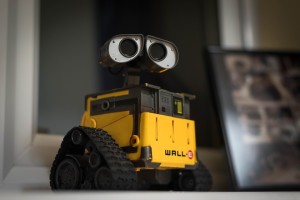Australia Leading the Way in Robot Innovation
January 15th, 2016 From the 1950’s Astro Boy and Iron Man comic illustrations to the more recent Wall-E and Chappie characters that lit up our cinema screens – undeniably, robots have frequently been depicted in works of fiction. However, in 2016 is fiction becoming more of an everyday reality?
From the 1950’s Astro Boy and Iron Man comic illustrations to the more recent Wall-E and Chappie characters that lit up our cinema screens – undeniably, robots have frequently been depicted in works of fiction. However, in 2016 is fiction becoming more of an everyday reality?
Indeed, for the past century, innovation in robots, machine and androids has been on an exponential curve. Certainly, 2015 was the tipping point in the global adoption of the Internet, digital medical devices, gene editing, drones, and solar energy. However, 2016 is set to be the beginning of an even bigger revolution and, most notably, Australia leading the way in several examples of machine innovation.
For instance, on the Great Barrier Reef, a robot formed to hunt for and regulate the crown-of-thorns starfish — liable for an estimated 40% decline in the reef’s coral cover — is being dispensed into the wild. The COTSbot, constructed by the Queensland University of Technology, will monitor the Great Barrier Reef and inject the destructive crown-of-thorns starfish with a fatal dose of bile salts. Using GPS technology and powerful thrusters, the robot is constructed to cruise about a metre above the coral surface and using visual recognition technology, will look for the pests. The robot innovation is predicted to greatly assist in the eradication of crow-of-thorns starfish, hence, reducing one of the most significant threats to the Great Barrier Reef.
In addition, machine research in Australia is also spinning off new types of businesses. In Western Australia, a smartphone app for respiratory diseases is being tested at the Joondalup Health Campus. The technology is founded on machine learning algorithms which use only sound to diagnose and measure the severity of respiratory disorders without the necessity for supplementary hardware. The software application is now being taken to market by ResApp Health. The markets for ResApp’s technology include telehealth, emergency departments, clinics, at home use, and for the developing world where the customary hardware is too expensive.
Undeniably, machine innovation is being applied and researched at an increasing rate in Australia. Investment in technology via research and development (R&D) can aid companies in developing new products, equipment, machinery, processes and software that can aid their businesses cash flow, productivity and knowledge. Moreover, if a company is investing in research and development activities in Australia then they may be eligible for tax benefits. In fact, the government encourages businesses within Australia to do this by allowing business owners to offset research and development with the R&D Tax Incentive. Contact Swanson Reed today if you would like to talk to a specialised R&D Tax consultant about the scheme.
Categories
- ATO Guidance and Materials
- AusIndustry Guidance and Materials
- Case Law
- Federal Budget 2021
- Federal Budget 2022
- For Accountants
- General Information
- Government Policy and Treasury
- Industry Specific Issues
- Interpretative Decisions
- Legislation and Parliamentary Matters
- R&D Tax Credit
- R&D Tax Funding Strategies
- R&D Tax Loans
- Recent News
- Tax Determinations
Archives
- April 2024
- March 2024
- February 2024
- January 2024
- December 2023
- November 2023
- October 2023
- September 2023
- August 2023
- July 2023
- June 2023
- May 2023
- April 2023
- March 2023
- February 2023
- January 2023
- December 2022
- November 2022
- October 2022
- September 2022
- August 2022
- July 2022
- June 2022
- May 2022
- April 2022
- March 2022
- February 2022
- January 2022
- December 2021
- November 2021
- October 2021
- September 2021
- August 2021
- July 2021
- June 2021
- May 2021
- April 2021
- March 2021
- February 2021
- January 2021
- December 2020
- November 2020
- October 2020
- September 2020
- August 2020
- July 2020
- June 2020
- May 2020
- April 2020
- March 2020
- February 2020
- January 2020
- December 2019
- November 2019
- October 2019
- September 2019
- August 2019
- July 2019
- June 2019
- May 2019
- April 2019
- March 2019
- February 2019
- January 2019
- December 2018
- November 2018
- September 2018
- July 2018
- June 2018
- May 2018
- April 2018
- March 2018
- February 2018
- January 2018
- December 2017
- November 2017
- September 2017
- August 2017
- July 2017
- June 2017
- May 2017
- April 2017
- March 2017
- February 2017
- January 2017
- December 2016
- November 2016
- October 2016
- September 2016
- August 2016
- July 2016
- June 2016
- May 2016
- April 2016
- March 2016
- February 2016
- January 2016
- December 2015
- November 2015
- October 2015
- September 2015
- August 2015
- July 2015
- June 2015
- May 2015
- April 2015
- March 2015
- February 2015
- January 2015
- November 2014
- October 2014
- September 2014
- August 2014
- July 2014
- June 2014
- May 2014
- April 2014
- March 2014
- February 2014
- January 2014
- December 2013
- November 2013
- October 2013
- September 2013
- May 2013
- April 2013
- March 2013
- September 2012
- August 2012
- June 2012


 Free Call: 1300 009 390
Free Call: 1300 009 390





 News & Research
News & Research



